
Garde-Robe at the Palace of the Popes
Toilets of the Avignon Papacy
Medieval Toilets of Royalty and Nobility
How many Popes are there,
and where do they live?
That sounds like a trick question!
Just one, of course, and he lives in the Vatican, in Rome.
Well, now, yes.
But things were very different in the 14th century.
A Pope moved his entire court in 1309 to
Avignon in what today is southern France.
Six following Popes, ruling through 1378,
kept the headquarters of the Roman Catholic church
in Avignon.
Then the last of the seven Avignon Popes moved his papal
operation back to Rome.
He died there just over a year later,
leading to a schism in which there were two powerful factions
of church figures,
one of them saying that the actual Pope,
and thus his successor,
had moved back to Rome,
while the other insisted that the actual Pope was
the successor that they had elected in Avignon.
A group of church officials decided that
they needed to meet in Pisa and elect a new Pope
who would replace the competing ones in Rome and Avignon.
But, as might have been expected, the result was
three popes,
in Avignon, Rome, and Pisa, each of them insisting that he
was the only Pope.
That went on from 1409 through 1415, when things got
more or less straightened out.
Except for the extraneous Pope remaining in Avignon,
who eventually fled to a castle in the Kingdom or Aragon
where the locals recognized him as Pope in exile until
his death in 1423.
Now, where did these various Popes poop?
Into a chamber pot held within a close stool,
maintained by the Groom of the Pope's Stool,
like the rest of enormously wealthy European royalty.
But what about the Pope's lackeys and henchmen,
his numerous official visitors,
and the even more numerous people attending the
lavish feasts thrown by the Avignon Popes?
They would have pooped in the
garde-robe.
That sounds like the coat-check area
but actually it was a small booth
projecting from an outer wall of the Papal palace,
several levels above the ground.
Let's learn about the Avignon Papacy and then see what
remains of the garde-robe
within the opulent Palace of the Popes.
Wait, Isn't This All Scandalous Lies?
CatholicEncyclopedia
Scandalous, perhaps. But the background is mostly from the Catholic Encyclopedia of 1907–1914, now out of copyright and available online. Many of the Wikipedia pages on the characters and events are largely copy-pasted from there.
Rome's Collapse and Corruption
The western Roman Empire had collapsed through the late 5th century. The barbarian leader Flavius Odoacer deposed Romulus Augustulus in 476, ending the rule of the last Western Roman Emperor.
The peninsula of Italy was divided up between several feuding small kingdoms and city-states. Italy is a peninsula, it only became a unified nation in 1871.
Byzantine Emperor Justinian I conquered the Italian peninsula in the Gothic War of 535-554, and appointed the next three Roman Popes. For almost two centuries, until 752, all Popes of Rome were approved by the Byzantine Emperor in Constantinople. Spoiler alert: by 1054 the Byzantine Patriarch, the Bishop of Constantinople, had washed his hands of the whole mess.
In 756 the Frankish King Pepin III gave land to the then-current Pope of Rome and then invaded northern Italy to drive out the invading Lombards. This land, the Papal States, came with a huge increase in secular power and wealth. And, it provided reasons or at least excuses for other secular leaders to meddle in Papal appointments.
In 800, Pope Leo III crowned the Germanic leader Charlesmagne as Holy Roman Emperor. Now there was a distant family of German-speaking rulers who could begin interfering with the selection of Popes. But without rapid communication, the Germans were at a disadvantage. Powerful Italian families became involved and soon took control of the Pope-selection process.
The Popes of the 10th century and the first half of the 11th
were spectacularly corrupt.
Spectacularly Corrupt Popes of the 10th and 11th Centuries
There were multiple cases of a pope setting up one of his illegitimate sons as his successor. Some Popes were enthroned when just 18 years old. A partisan of Holy Roman Emperor Otto I accused Pope John XII of ordaining children, incest, and violence. A later successor Pope wrote of the "rapes, murders, and other unspeakable acts of violence and sodomy" committed by Pope Benedict IX.
By now the Bishop of Constantinople had had more than enough of the immoral Bishops of Rome. In the Great East-West Schism of 1054, the Bishop of Constantinople and the Bishop of Rome excommunicated each other.
The Roman faction began touting the Donation of Constantine, a forged document purportedly from Constantine the Great (ruled 306–337) giving vast territories and broad authority to the Bishop of Rome.
The French King and the Pope
King Philip IV of France, who ruled 1285–1314, decreed that gold, silver, precious stones, and food could not be exported from France to the Papal States. This blocked a primary source of Papal revenue.
Jesus answered, “I am the way, the truth, and the life.
No one comes to the Father except through me."
— John 14:6
(no mention of the Bishop of Rome)
Pope Boniface VIII argued that the Pope was a spiritual monarch ruling over all Earthly kings, and that "it is necessary to salvation that every human creature be subject to the Roman pontiff." It was that Donation of Constantine again. Philip IV disagreed. He responded with a zinger:
Your venerable conceitedness may know that we are nobody's vassal in temporal matters.
So, Boniface VIII immediately excommunicated King Philip and "all persons impeding French clerics".
Boniface VIII was in power until 1303. Dante Alighieri didn't care for Boniface, depicting him as on his way to the Eighth Circle of Hell in the Divine Comedy.
Boniface VIII was followed by the Italian Pope Benedict XI, who was in office for just eight months. The College of Cardinals had wanted a Pope who wouldn't be overly hostile toward the King of France. Benedict un-excommunicated King Philip, but within a year he had excommunicated many powerful figures close to the King.
Then Benedict died suddenly and suspiciously at Perugia. The French King's minister Guillaume de Nogaret was suspected of having poisoned Benedict.
Suddenly, a French Pope
There was a Popeless gap of a year while the French and Italian cardinals quarreled. They finally selected Raymond Bertrand de Got, born in Villandraut, Aquitaine. For a Papal candidate he was, unusually, neither Italian nor a cardinal. But he was a friend of the King of France. It's good to be the King. Or the King's friend.
Raymond took the name Pope Clement V. He was at Bordeaux when he was formally notified of his election to the Papacy, and he was told to travel to Italy. But instead, he selected Lyon for his coronation in 1305. King Philip attended. Pope Clement V immediately created nine new French cardinals, providing a numerical advantage for France in the conclave for the next Pope. He doesn't seem to have ever visited Rome, but resided and set up his court at Bordeaux and Poitiers.
In 1306 and 1307 he withdrew Boniface's Papal bulls that asserted Papal authority over all national leadership.
King Philip IV had been charging the Knights Templar with usury, credit inflation, fraud, heresy, sodomy, immorality, and other abuses. So, later in 1307 Clement had hundreds of them arrested in France.
The Move to Avignon
Seven Popes resided in Avignon:
• Clement V
1305–1314
• John XXII
1316–1334
• Benedict XII
1334–1342
• Clement VI
1342–1352
• Innocent VI
1352–1362
• Urban V
1362–1370
• Gregory XI
1370–1378
Clement's Papal court had been at Poitiers, in west-central France to the north of Clement's home. In March 1309 he moved his court to Carpentras, near Avignon. The territory was officially part of the Kingdom of Arles within the Holy Roman Empire. However, the French King controlled the land on the opposite bank of the Rhône and had stronger influence over the Vaucluse than the remote Emperor in German-speaking territory far to the north.
King Philip IV leaned hard on Clement, pressuring him into subjecting Boniface VIII, dead for six years at that point, to a posthumous trial for heresy, later expanded to include sodomy. Clement pardoned Guillaume Nogaret for offenses against Boniface and the church, de-excommunicating Nogaret on the condition that he go to the Holy Land and serve with the next wave of soldiers. Clement also formally excused the King for everything he had said and done against Boniface, and he later officially disbanded the Order of the Knights Templar.
Clement's successor John XXII moved the Papal court into Avignon itself. Below we are looking across the Rhône river, with Avignon's medieval city walls running along the river surrounding the opulent Palace of the Popes or the Palais des Papes rising above the trees at right.
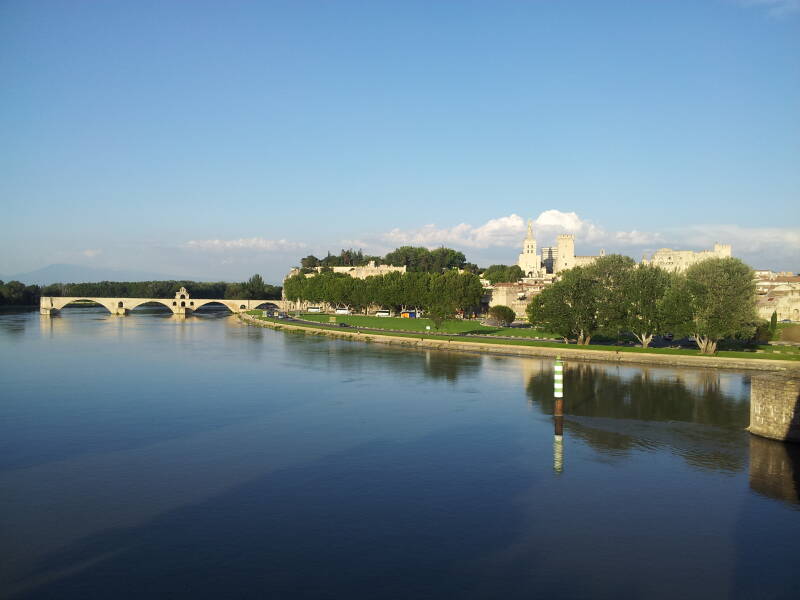
Beginning the "Babylonian Exile"
Jacques Duèze had studied medicine in Montpellier in southern France, and law in Paris, and taught both canon and civil law. He became Bishop of Fréjus in 1300, and transferred to Avignon in 1310.
Pope Clement V died in 1314. Although he had stacked the deck by adding several French cardinals, there was another Popeless interregnum for two years. King Philip finally set up a conclave of 23 cardinals in Lyon. They elected and crowned Duèze, who took the name Pope John XXII.
Pope John XXII felt that the Spirituals movements had way too much enthusiasm for the concepts of the Absolute Poverty of Christ and Apostolic Poverty. He officially condemned the pro-poverty group known as the Fraticelli in 1317.
In 1322 he convened a group of experts to study the idea that Christ and the apostles owned nothing. And by "study" it was clear that "reject" was the expected result.
There was some disagreement, apparently not everyone had gotten the message that the Pope had a specific pro-Papal-wealth outcome in mind. But, the majority rejected the idea, as it would condemn the church's right to own property and treasures. The followers of Francis of Assisi objected, but the Pope issued a bull declaring the doctrine that Christ and his apostles had no possessions to be "erroneous and heretical". He later issued other bulls declaring that he was correct, and that earlier bulls asserting poverty were actually wrong.
Today's greed-driven "Prosperity Gospel" preachers are firmly on the side of Pope John XXII.
All of them must follow John XXII in avoiding all mention of the episode when Jesus violently drove out the money-changers and sacrifice-sellers preying on poor women in the Temple.
He found in the temple those who were selling cattle, sheep, and doves, as well as those involved in exchanging currency sitting there. He made a whip from ropes and chased them all out of the temple, including the cattle and the sheep. He scattered the coins and overturned the tables of those who exchanged currency. He said to the dove sellers, "Get these things out of here! Don’t make my Father’s house a place of business."
Some pundits of the time began referring to the Avignon Papacy as the "Babylonian Exile" of the Roman church. The Pope and his court in Avignon agreed because, oh dear, didn't they have it rough living in a city that hadn't been the capital of an empire? Why, they were just like the unfortunate exiled Jews of the 6th century BCE! Or so they thought of it.
But the writers had meant "Babylonian Exile" as ironic criticism, with emphasis on "Babylonian". The supposed "exile" was in a city that was rapidly becoming more and more opulent, like Babylon at its peak.
The Avignon Popes used gold and silver dishes at banquets, and wore expensive outfits. Churches were billed an annual tithe or 10% on property; first years' salaries for bishops were taken as annates, and pardons were sold along with dispensations to allow illiterate men to become priests and for converted former Jews to visit unconverted parents.
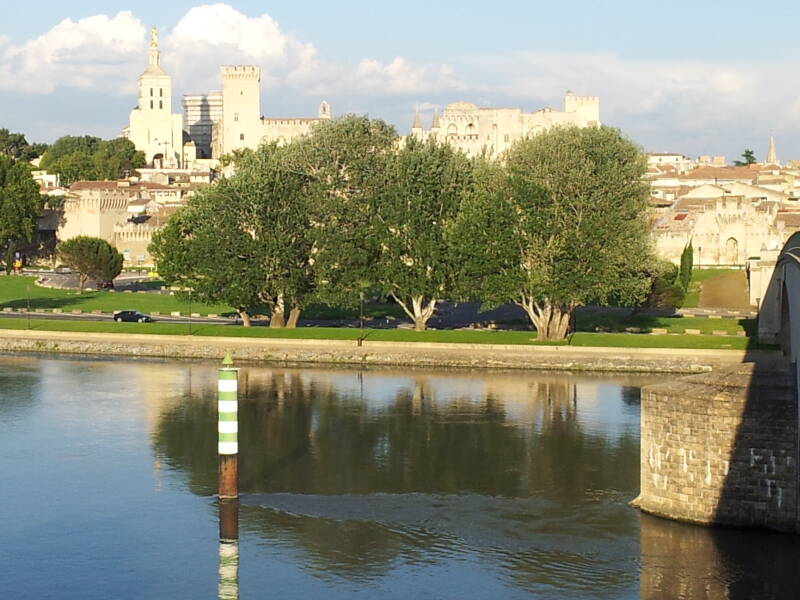
In 1348 Clement bought the town of Avignon from Joanna I, Queen of Naples and Countess of Provence, for 80,000 florins.
The Papal library in Avignon became the largest in Europe in the 14th century, with 2,000 volumes. Pope Boniface VIII had formed the University of Avignon from the existing schools in the city in 1303.
The stone Pont Saint-Bénézet, commonly called the Pont d'Avignon, originally had twenty-one piers. Only four remain, and the bridge ends out in the middle of the river.
A bridge was built here between 1177 and 1185, possibly all wooden, or maybe wood spans between stone piers. It was destroyed in 1226 during the Albegensian Crusade, when King Louis VIII of France besieged Avignon.
The bridge had strategic significance. It was the only river crossing between the territories controlled by the Pope and by the King of France. It was also the only bridge across the Rhône from Lyon all the way downstream to the Mediterranean, a distance of 310 kilometers.
The all-stone bridge was started in 1234. It was abandoned in the mid 1600s, because arches would collapse during major floods of the Rhône. It was missing four of its 22 arches by 1644. A large flood in 1669 carried away more of the bridge. More arches have collapsed or been demolished over the years, so only four arches remain today.
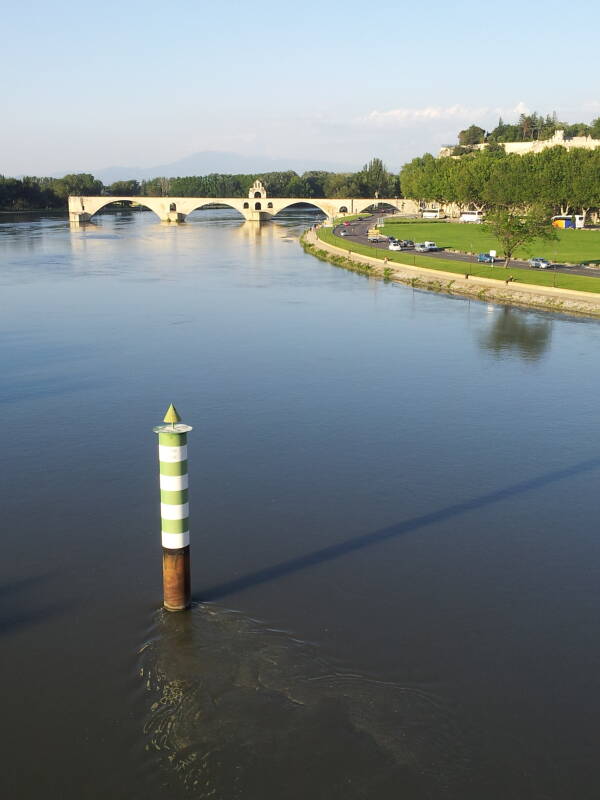
The first few Avignon Popes built the walls around the city. They look impressive but they're made of soft limestone. The Popes relied on their sturdy palace, the Palais des Papes. It's built on the 35-meter-tall Rocher des Doms, a stone outcropping, and its walls are five and a half meters thick.
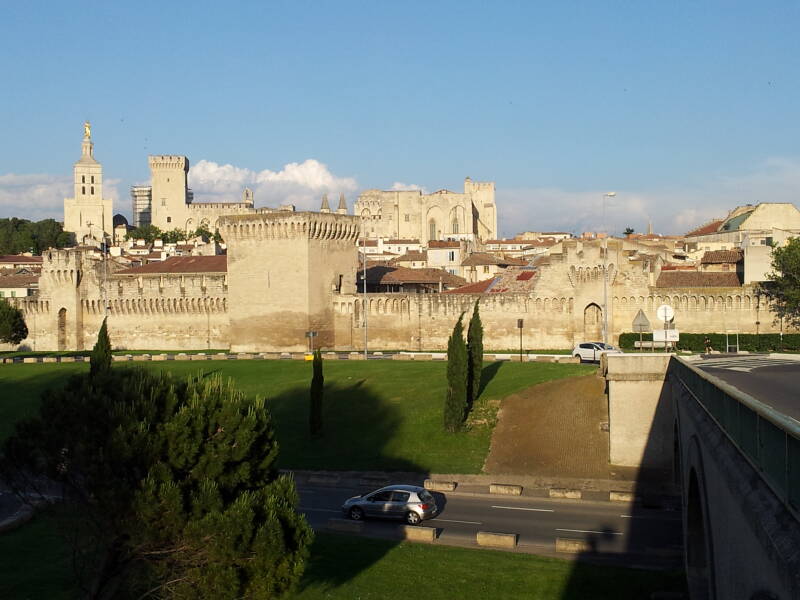
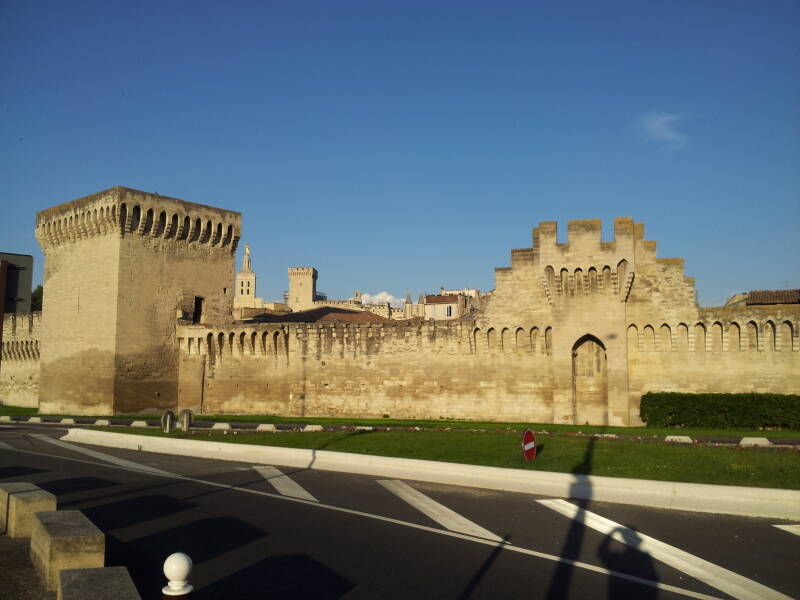
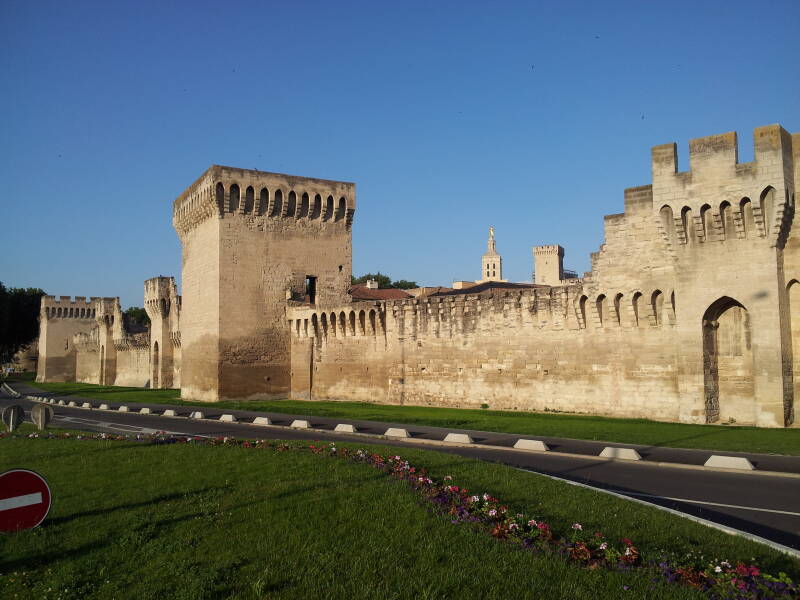
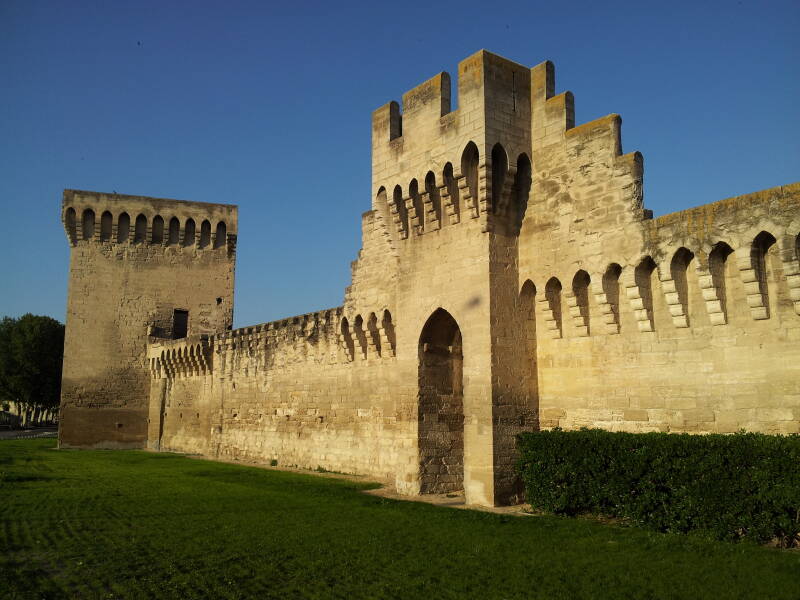
Notre Dame des Doms, the cathedral, was mostly built in the 12th century. It's to the left in the below picture. Its bell tower was rebuilt in 1425, topped by a gilded statue of the Virgin Mary in 1859.
The Palais des Papes, the Palace of the Popes, is the large building to its right. This is just a small segment at one end. It's the largest medieval Gothic palace in Europe.
Pope Benedict XII (in office 1334-1342) built the Old Palace on the high Rocher des Doms, where the old episcopal palace of the Bishops of Avignon had stood. His successor Pope Clement VI (1342-1352) extended this by building the New Palace. It occupied an area of 11,000 square meters (or 118,400 square feet) by the time it was finished.
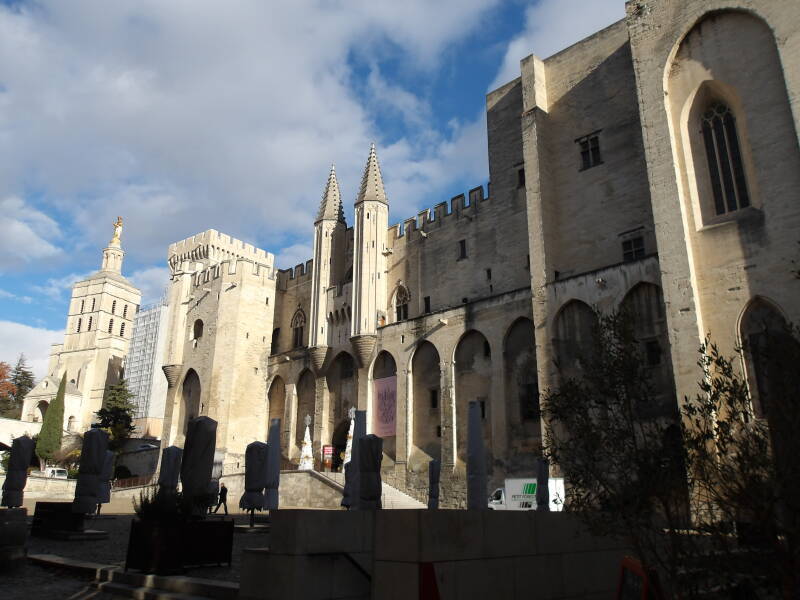
The enormous size allowed the church bureaucracy to grow. The Curia, the Papal administration, had 200 employees in the late 1200s. It was over 300 by 1300, and had grown to 500 by 1316. In addition to this, there were over 1,000 lay officials working within the Palace for the Pope's administration. Successive Popes continued reconstruction until 1364, adding towers to put their personal flourishes on it.
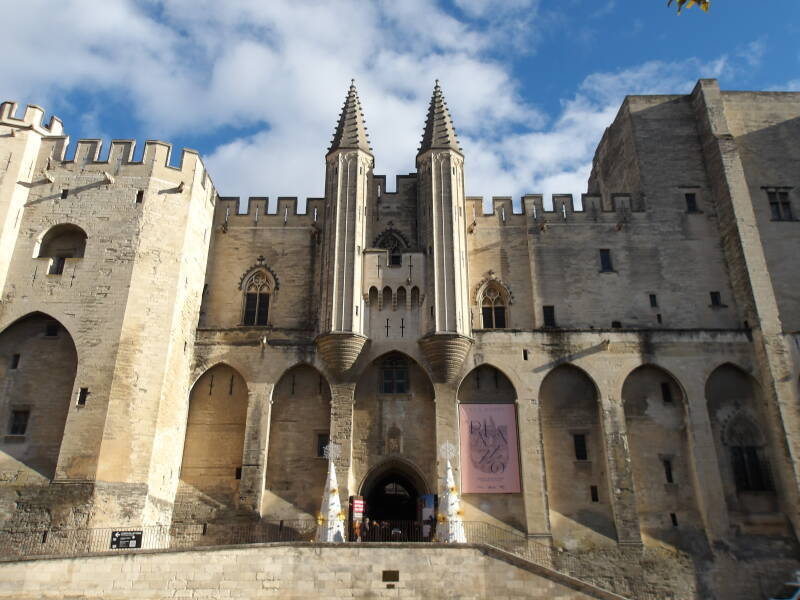
The Palace remained under Papal control until the French Revolution, when it was already in bad shape before being sacked by Revolutionaries. Like many historic sites, it became a prison under Napoleon. It became a museum in 1906.
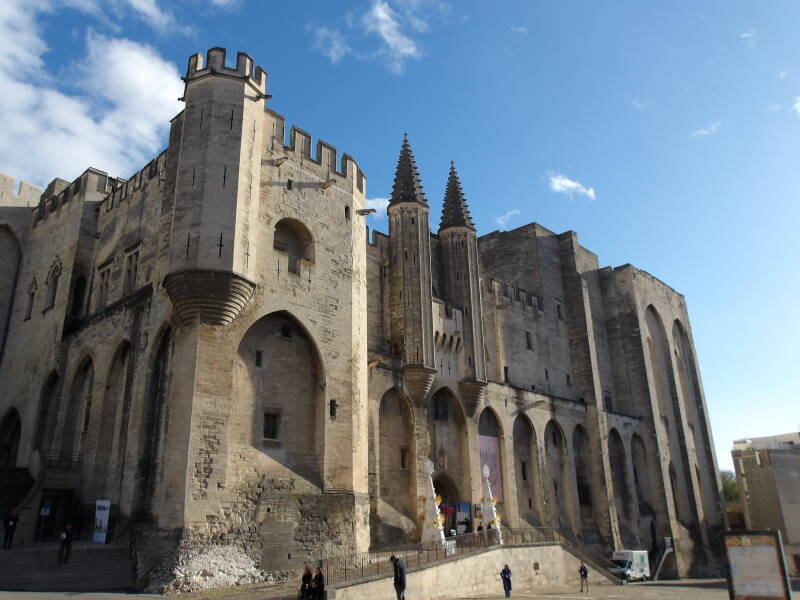
The Palace of the Popes was built on a grand scale and opulently decorated. The Popes regularly hosted huge feasts. Here is one of the feasting halls.
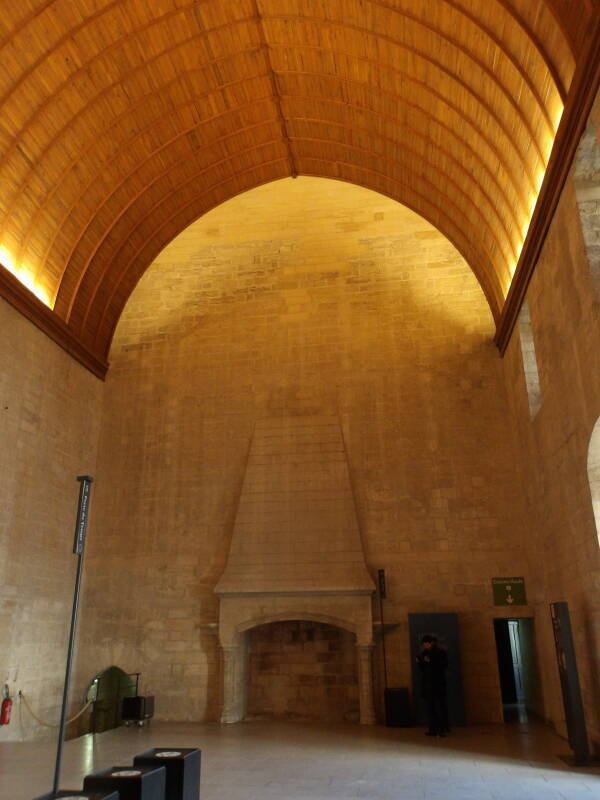
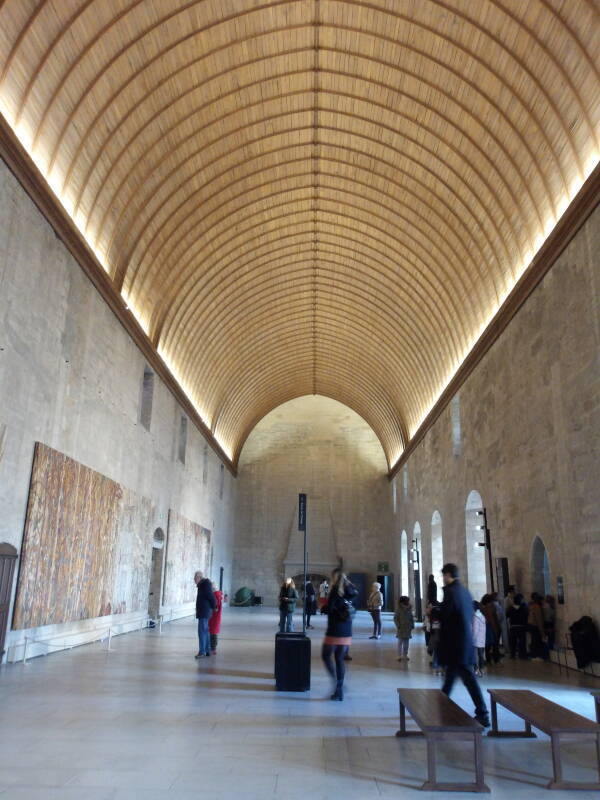
Moving to the far end, as seen above, you can get some sense of the scale of the feasting facilities.
All those guests called for a lot of food, so the kitchen is accordingly large. Below we're looking up its central chimney.
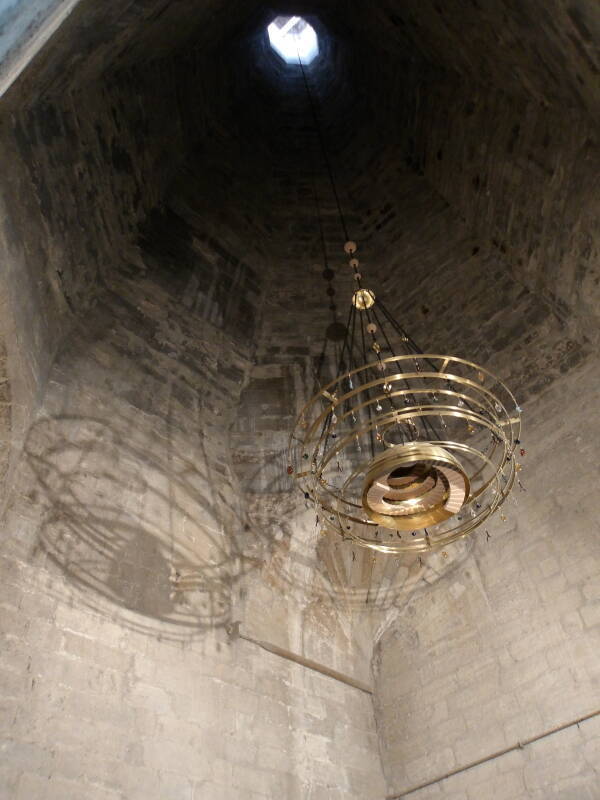
Pope Urban V, who ruled 1362–1370, decided to return the Papacy to Rome. However, Rome had really gone downhill. When Clement had moved to Avignon, Rome had already become uncontrollable. Now it was worse. The city was filled with battles between the military forces of aristocratic Roman families. The Lateran Basilica, the cathedral church of Rome and the seat of the Roman pontiff, had been destroyed in a fire. The Papal States had been entrusted to a team of three cardinals who only very loosely controlled the territory. Papal military forces were fighting the Venetian army. Urban turned around and returned to Avignon.
Pope Gregory XI, just as French as the other six Avignon Popes before him, also planned to return the Papacy to Rome. He managed to pull that off, arriving in January of 1377. However, he died just over a year later, in March 1378. That led to the Western Schism.
Two Popes At Once
Romans rioted after Pope Gregory XI died, demanding that the next Pope had to be from Rome. But, there was no one in Rome who was remotely qualified for the job.
The cardinals elected Bartolomeo Prignano from Naples, who was the Archbishop of Bari. At least he was Italian. He took the throne as Pope Urban VI.
He had been a good administrator in the offices in Avignon, but he was not suited to be Pope. He was suspicious and prone to fits of rage. Most of the cardinals who had just elected him immediately regretted their choice. The majority of them left for Anagni, a hill town southeast of Rome, where they had a new conclave and elected a rival Pope.
Pope #2, Robert of Geneva, took the name Clement VII. Since Rome was occupied and Avignon was all set up for Papal operations, he went to Avignon.
This was a mess. There had been Antipopes before, claimants to the Papal throne. But this time there were two Popes selected by the same group of church leaders. Foreign national leaders had a choice of two Popes.
| Avignon: Clement II | Rome: Urban VI |
| Denmark, England, Flanders, Holy Roman Empire, Hungary, Ireland, Norway, Portugal, Poland(-Lithuania), Sweden, Republic of Venice and other northern Italian city-states | France, Burgundy, Savoy, Aragon, Castile and León, Naples, Cyprus, Scotland, Wales |
When each died, their faction selected a replacement. Boniface IX (1389-1404) in Rome and Benedict XIII (1394-1423) in Avignon.
When Boniface died in 1404, the 8 cardinals backing him offered to not elect a new Pope if Benedict would step down, although what did they really expect to happen then? Benedict refused, of course! So now there was a new Pope Innocent VII in Rome.
| Avignon | Rome |
| Clement VII (1378-1394) | Urban VI (1378-1389) |
| Benedict XIII (1394-1423) | Boniface IX (1389-1404) |
| Innocent VII (1404-1406) |
Pisa Adds a Third Pope
The word nepotism comes from the pattern of Popes giving powerful positions to their nephews.
Gregory XII had already created four new cardinals in 1408, two of them his nephews, despite promising before his election to keep things as they were. The existing cardinals complained, and refused to attend the service where the four new cardinals would be installed. One of the protesting cardinals left for Pisa.
The Pope sent one of his nephews, along with military backup, to seize the absent cardinal and bring him back by force. That caused seven more cardinals to leave immediately, followed by another who was just arriving.
The protesting cardinals published a manifesto calling for a general council in Pisa in 1409, hoping to end the schism. Pope Benedict XIII in Avignon called for a council of his own. The Roman Pope Gregory XII said that he was also going to have an independent council, but he fled with the one cardinal who had remained faithful to him.
The Universities of Paris, Oxford, and Cologne, along with many distinguished scholars of church law, sent delegates to Pisa in support of the protesting cardinals. Royal leaders, on the other hand, no longer had to care as they no longer relied on the support of the rival Popes. Meanwhile the Greek patriarch in Constantinople had gotten out of the whole mess almost four centuries ago, and already had plenty on his plate with the encroaching Turks and the shrinking Byzantine Empire. The Patriarch of All Russia just said "Third Rome is Best Rome" and ignored the continuing mess far to the west.
The College of Cardinals, the supporters of both Rome and Avignon, met for the Council of Pisa in March 1409. They hoped to end the Western Schism by deposing both Benedict XIII in Avignon and Gregory XII in Rome. As there was no one undisputed pope to call for a general council, the Holy See should be considered vacant. It was up to them to elect an undisputed pope. They were 22 cardinals, 80 bishops, and 4 patriarchs, plus representatives of 100 bishops and 87 abbots who couldn't make it to Pisa, plus 300 doctors of theology or canon law, plus ambassadors from all the Christian nations. They were meeting under the presidency of a cardinal who had been named before the Schism had begun. What could possibly go wrong?
"This will be easy", they figured. "Accuse them both of schism and manifest heresy, obviously both of them will step down, and we'll elect a single replacement. Problem solved!"
It did not go well.
When they finally got around to reading the document listing all the charges against the two Popes, it took over three hours.
Two months later the Patriarch of Alexandria read the group's decision. Benedict XIII and Gregory XII were schismatics, notorious heretics, guilty of perjury, violators of promises, and unworthy of the office of Pope. They were forbidden to consider themselves as Supreme Pontiffs, and everything they had done was annulled. The seat of the Holy See was declared to be vacant.
Everyone at the council was happy, but Benedict and Gregory had no plans of going along with the decision.
The cardinals in Pisa then elected a new Pope, Alexander V.
Now there were three Popes — Benedict XIII in Avignon, Gregory XII in Rome, and Alexander V in Pisa.
One common complaint about the Council of Pisa (in addition to adding a third Pope) was that they weren't necessarily authoritative. If bogus Popes appoint a group of bogus cardinals, can those bogus cardinals really elect a true Pope to replace the two bogus Popes?
But for now, the Pisa line of Popes continued. England, France, Bohemia, Portugal, parts of the Holy Roman Empire, and some Italian city-states recognized the Popes of Pisa.
| Avignon | Rome | Pisa |
| Clement VII (1378-1394) | Urban VI (1378-1389) | Alexander V (1409-1410) |
| Boniface IX (1389-1404) | ||
| Benedict XIII (1394-1423) | Innocent VII (1404-1406) | |
| Gregory XII (1406-1415) | John XXIII (1410-1415) |
The Council of Constance in 1414-1418 finally straightened things out. Somehow they managed to make the case that all three of the current Popes were invalid, and they were going to elect one that would be the One True Pope. That was Martin V.
Pope Benedict XIII (Avignon) simply refused to accept the decision of the Council of Constance. The Holy Roman Emperor sent representatives, joined by diplomats of several nations, but Benedict said he was still the Pope. Eventually, when Martin V was elected Pope, meant to be the only one, Benedict fled to a castle in the Kingdom of Aragon, a kingdom corresponding to the modern-day autonomous community of Aragon in Spain. Only the Kingdom of Aragon recognized the claim of Benedict XIII. He stayed there in Aragon, insisting that he was the Pope until he died in 1423.
Pope John XXIII (Pisa) attended the Council of Constance, at least for a while. Things quickly turned against the idea of a Third Pope. Disguised as a postman, John XXIII fled downriver along the Rhine, accompanied by Frederick IV, Duke of Austria. He was forcibly returned to the council, where he was tried and found guilty for heresy, simony, schism, and immorality. Gibbon's The Decline and Fall of the Roman Empire reports: "The more scandalous charges were suppressed; the vicar of Christ was accused only of piracy, rape, sodomy, murder and incest." Gibbon was always grinding his anti-religion ax, but you do wonder what all John XXIII got up to. John was imprisoned in Germany, but ransomed by the Medici.
Gregory XII (Rome) was the only one with a graceful end. He was convinced to resign, and retired from public life. His was the last Papal resignation until Benedict XVI in 2013.
After this episode of three competing Popes (plus some extraneous Anti-Popes as usual), and the mayhem of the 10th and 11th centuries, the notorious Borgia family decided to get a piece of the Papal action. From the mid 1400s into the 1500s, they exerted control over Papal elections and actually had a few Borgias elected as Popes, and also were accused of theft, bribery, and murder by arsenic poisoning, along with adultery and incest.
But What About the Garde-Robe in Avignon?
A garde-robe or just garderobe could refer to a cabinet in which you store clothing.
However, when discussing medieval architecture, it usually refers to a privy, a small toilet, which despite calling it a privy may not be private.
A garde-robe is usually a small booth or cabin attached to the exterior face of a building. There's a seat with a hole beneath it open to the drop down the exterior wall to the ground. It's an elevated outhouse. Don't stand underneath! Here's a woodcut from 1576 showing garde-robes on the exteriors of two buildings.
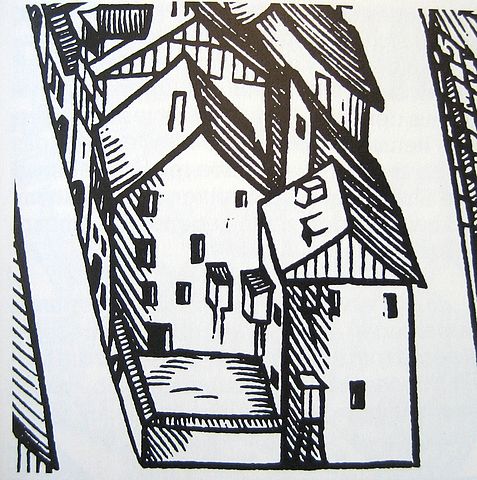
A garde-robe needed to be high enough above the ground to make it difficult for attackers to enter the castle by climbing up through the hole in the bottom of the toilet.
Yes, that happened, repeatedly. Once at Château Gaillard, Richard Lionheart's castle in Normandy.
ĒadmundIronside Uesugi
Kenshin
Also consider how the Japanese warlord Uesugi Kenshin and the English king Ēadmund Ironside died by being stabbed by assassins lurking beneath their toilets. Ēadmund's assassin was the son of a competitor, while Uesugi's was a ninja and in that case you're probably doomed no matter what.
The Erfurt Latrine DisasterIf you thought too much about it, the idea of doing your business in a small booth hung off the exterior wall might frighten you. But things might be far, far worse. Consider the Erfurt Latrine Disaster of 1184.
And so, I was going through the self-guided tour of the Papal palace in Avignon when I noticed something that was not called out on the official path. A door to the garde-robe!
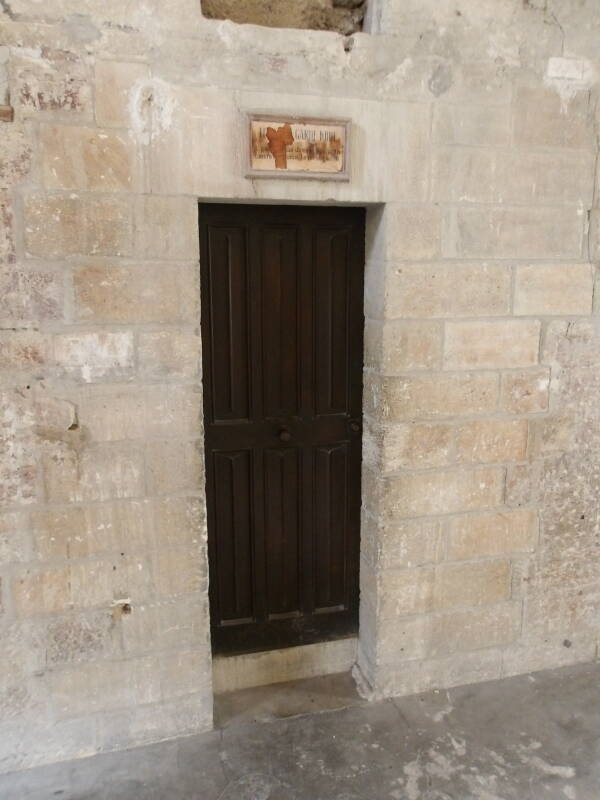
This was in one of the older sections of the castle, just before I continued into a much newer section. Notice the modified wall above the door.
When I had finished the tour inside, I went around to the rear of the palace to look for the garde-robe. It certainly wouldn't be on the front or near a frequently used entrance. Why? Imagine the brown streak down the side of the palace during the years when the garde-robe was in use. Imagine the smell.
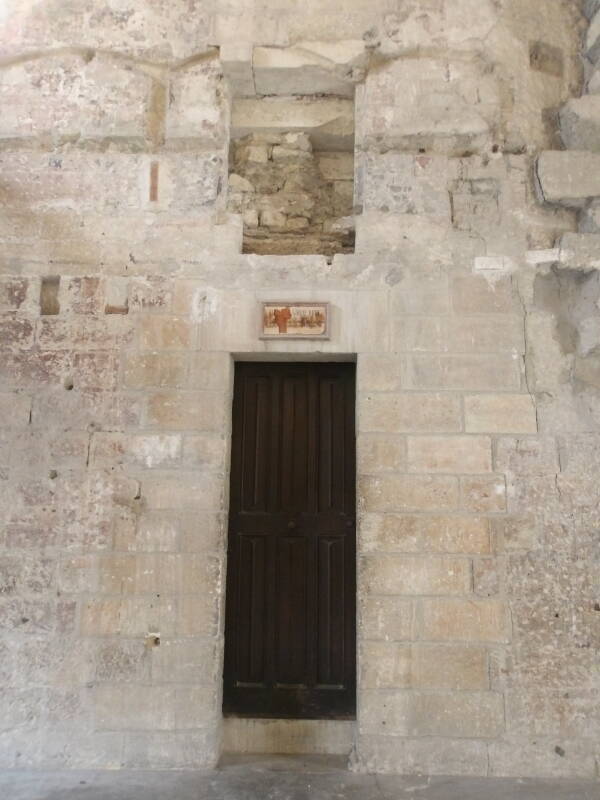
Around in back of the palace, go into a park next to the Promenade of the Popes. From the back side of that park, away from the footpath, you can see the rear of the palace down to one or two floors above ground level.
Notice that the tower in the left third of this picture is faced with smooth and clean-looking stone. It's a relatively new tower. To its right, starting with the shortest section visible from here, the stone is dirty and rough. That's a relatively old section. I spotted the garde-robe door inside when I was about to move from the old section into the newer tower. Maybe you have already noticed what we're looking for in this picture.
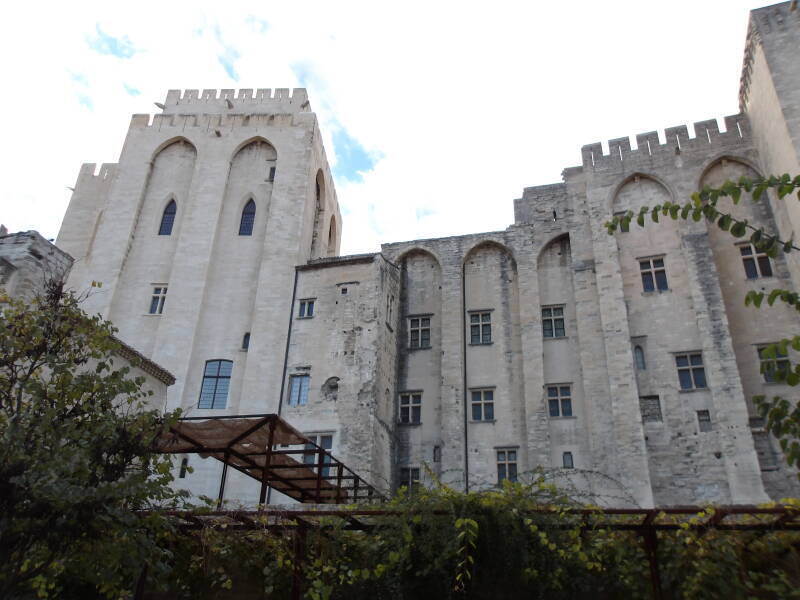
Here's a zoomed-in view of that connection between older and newer sections, where the garde-robe was attached. The suspended booth is gone. But you can see the arched doorway that led to it, now filled in with blocks, and a rectangular array of square holes below that, used to mount the garde-robe's supports.
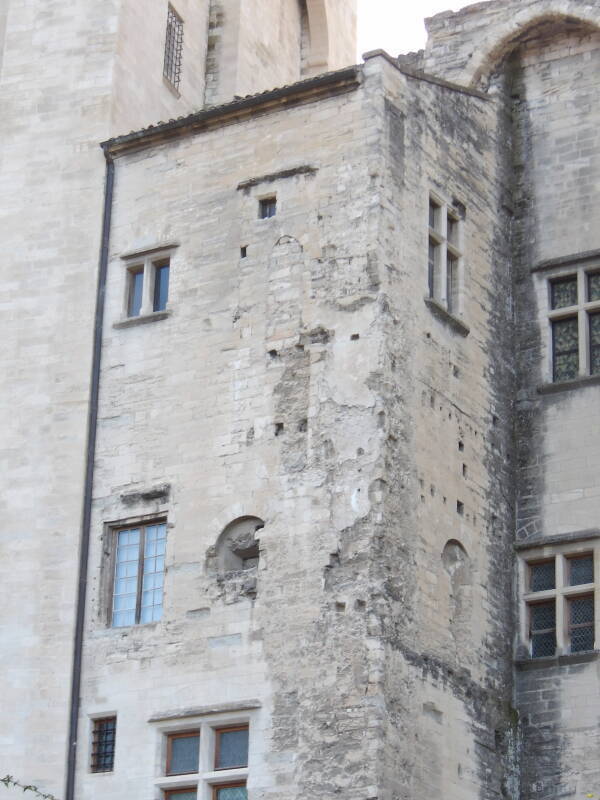
You can still find a suspended privy analogous to a garde-robe in today's France.
Canal Latéralà la Loire
Here is a modern garde-robe at one end of a bridge over a canal in Briare. I was here to start a boat trip along the Canal Latéral à la Loire through the Burgundy region. This bridge crosses a connection between the Briare Canal and the Canal Latéral à la Loire. The town has built a pissoir at one end of the canal, draining directly into the canal. Imagine this outhouse with the sloping roof attached to the sheer face of a castle or palace, over ten meters above the ground.
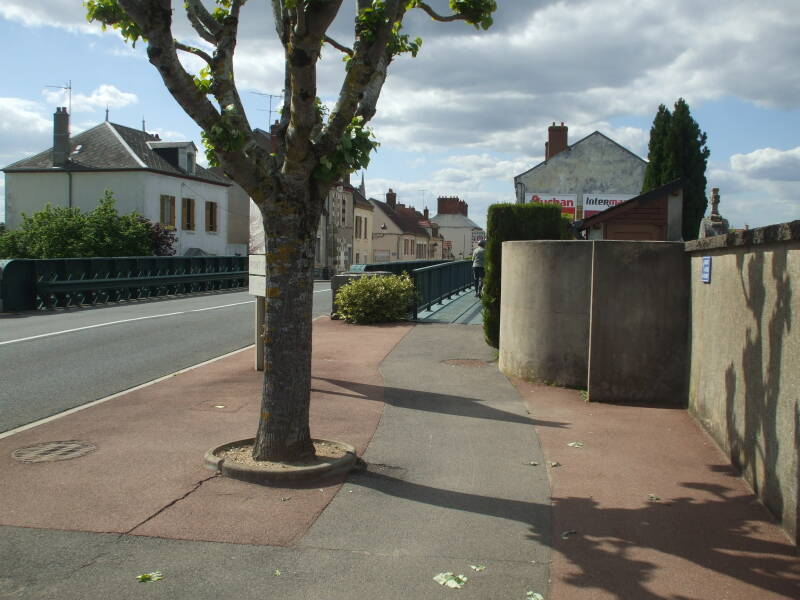
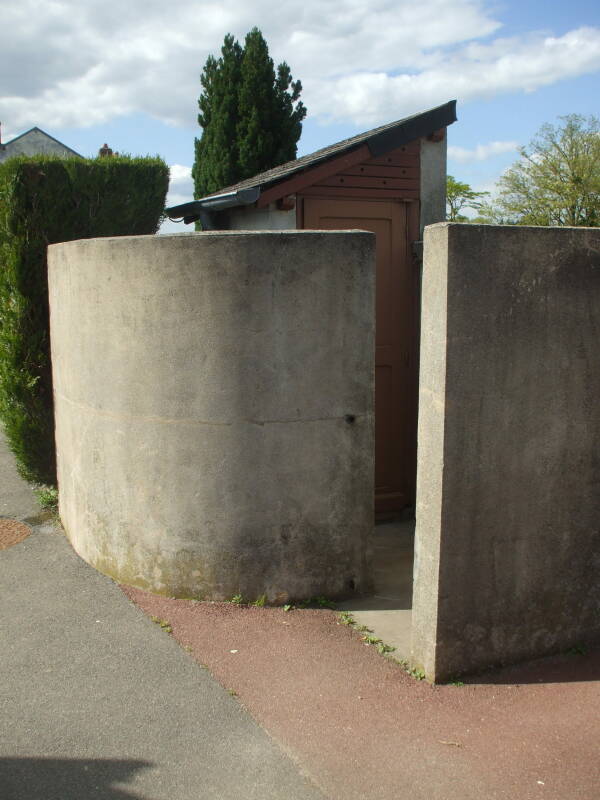
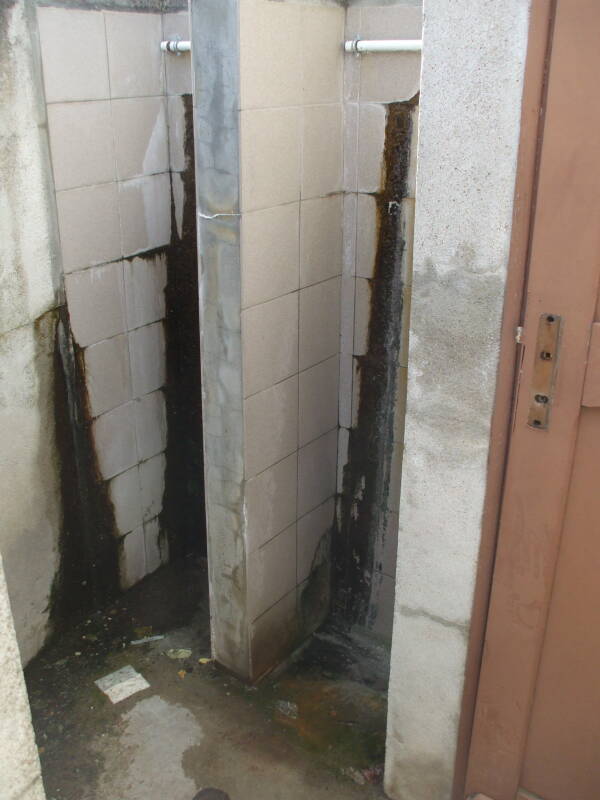
The facility also includes a squat toilet, which is plumbed into the town's sewage system.
Exactement! Urine in the canal is fine. Feces would cause health problems.
Three Simultaneous Popes But Just One Garde-Robe?
FireplaceUrination in
Shakespeare
I would think that there would have been more than the one. Also, the one I did spot might have opened out like a T as you stepped in, with multiple seats for multiple simultaneous users. And, this was the medieval period. Guys probably just peed into corners or into the fireplace, as Shakespeare described in Henry IV, Part 1.
Avignon After the Popes
Avignon and the surrounding territory continued to be Papal possessions until the French Revolution. The Hôtel des Monnaies, the Papal mint, was built in 1610.
However, the French Kings maintained a large military garrison directly across the Rhône at Villeneuve-lès-Avignon. Starting in the 1400s, the French Kings ruled Avignon as a part of their kingdom. Cardinal Richelieu was exiled to Avignon in 1618.
After the French Revolution, France expanded. Avignon and Comtat-Venaissin were combined with the former principality of Orange in 1793, forming the French département of Vaucluse. In 1814, the Pope recognized the annexation of Avignon.
Visiting Avignon
I was in Avignon briefly in 2008 and 2012, but I was kept very busy and did not get to tour the Papal Palace. I returned to the area in 2023, staying in Marseille, and visited Avignon on a day trip. Here's the airliner-style toilet on board TER, Transport Express Régional, the regional train service.
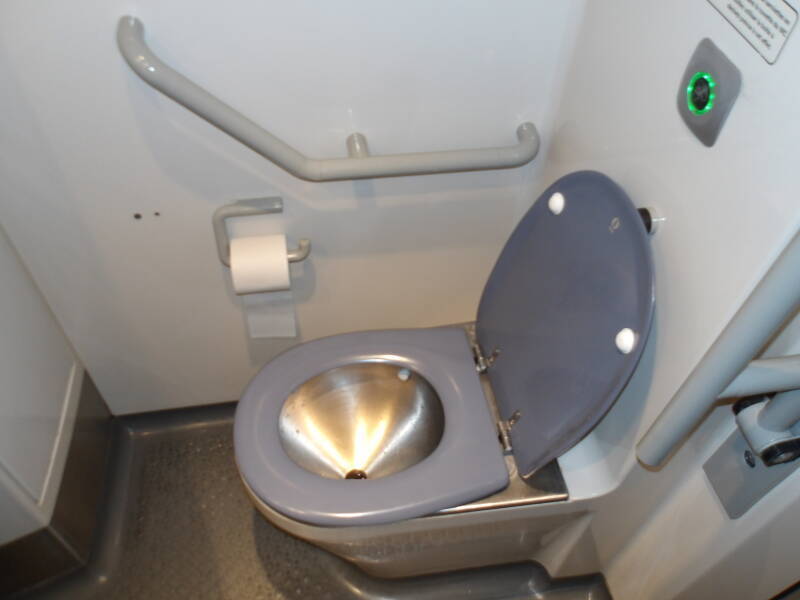
The high-speed TGV stops at a dedicated station well outside town. But the regional TER runs to and from Avignon Centre, the station along the south side of the old city walls. Here's a pair of urinals in the station.
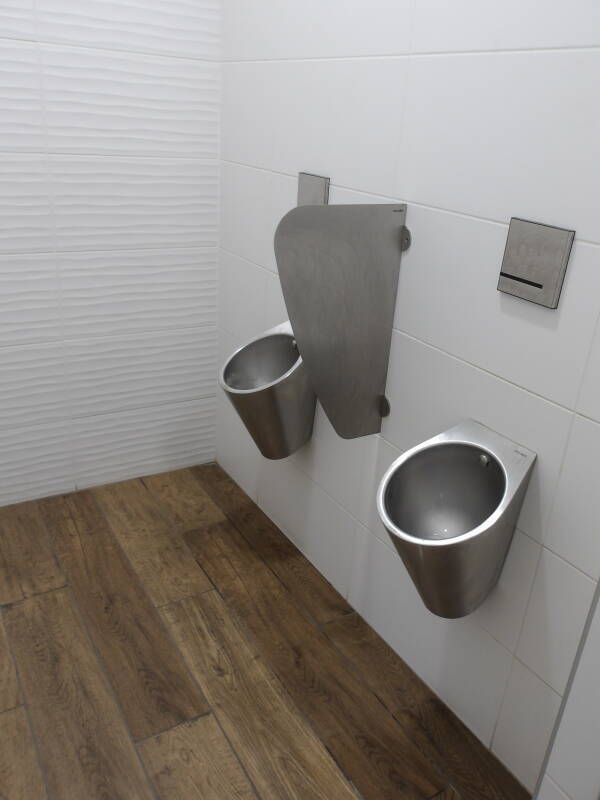
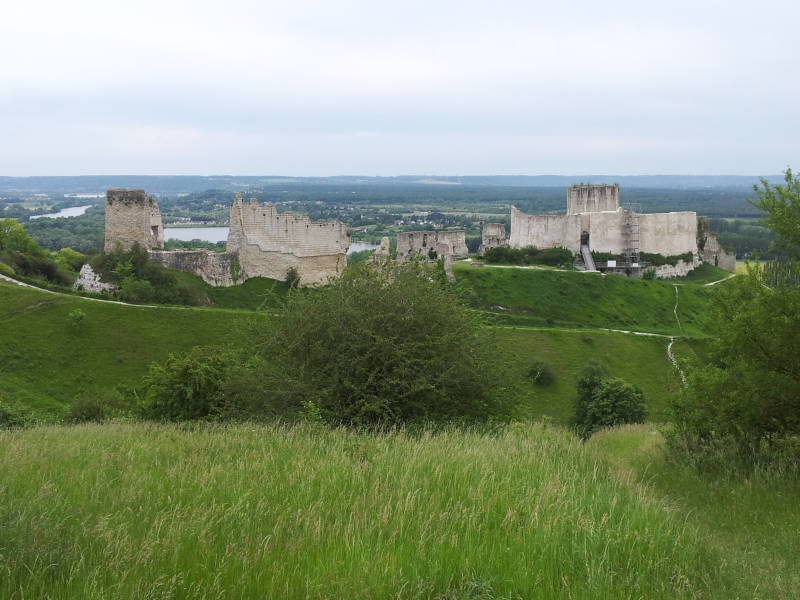
And, to be honest, the Pope is really the Bishop of Rome, not the Emperor of the Known Universe. Popes and Patriarchs are the highest ranking bishops of various non-Protestant churches. There's the Coptic Catholic Patriarch of Alexandria and all Africa, primate of the Coptic Orthodox Church of Alexandria; the Patriarch of Alexandria, Pope of All Africa and chief of the Greek Orthodox Church of Alexandria; the Patriarch of Constantinople; the Patriarch of Antioch, head of the Greek Orthodox Church of Antioch and All the East; the Patriarch of Jerusalem, head of the Eastern Orthodox Patriarchate in Jerusalem, over Israel, Palestine, Jordan and Arabia; the Patriarch of Moscow and All Russia; the Patriarch of All Bulgaria; the Patriarch of All Romania; the Catholicos-Patriarch of All Georgia; the Serbian Patriarch; the Syriac Catholic Patriarch of Antioch and all the East; the Maronite Catholic Patriarch of Antioch and all the East; the Patriarch of Baghdad of the Chaldeans, head of the Chaldean Catholic Church; the Patriarch of Cilicia of the Armenians, head of the Armenian Catholic Church; Patriarchs of the Ethiopian, Eritrean, Syriac, Indian, and Armenian Orthodox Churches; plus primates of smaller churches and various schismatic and recently formed movements. Not to mention Mel Gibson's dad.